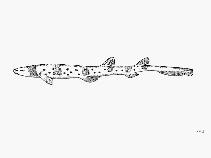Parascyllium collare Ramsay & Ogilby, 1888
Collar carpetshark
Ajouter votre observation dans Fish Watcher
| Native range |

|
| This map was computer-generated and has not yet been reviewed. |
| Parascyllium collare AquaMaps Data sources: GBIF OBIS |
Envoyez vos Photos et vidéos
Pictures | Images GoogleParascyllium collare
Photo de FAO
Pictures | Images GoogleParascyllium collare
Photo de FAO
Classification / Names Noms communs | Synonymes | Catalog of Fishes(Genre, Espèce) | ITIS | CoL | WoRMS | Cloffa
Élasmobranches (requins et raies) (sharks and rays) > Orectolobiformes (Carpet sharks) > Parascylliidae (Collared carpet sharks)
Etymology: Parascyllium: para (Gr.), near, i.e., presumed to be related to Scyliorhinus (now in Scyliorhinidae): skylion, Greek for dogfish or small shark (See ETYFish); collare: Latin for iron band or chain for neck, referring to prominent dark and unspotted collar around gills (See ETYFish).
More on authors: Ramsay & Ogilby.
Etymology: Parascyllium: para (Gr.), near, i.e., presumed to be related to Scyliorhinus (now in Scyliorhinidae): skylion, Greek for dogfish or small shark (See ETYFish); collare: Latin for iron band or chain for neck, referring to prominent dark and unspotted collar around gills (See ETYFish).
More on authors: Ramsay & Ogilby.
Environment: milieu / climate zone / depth range / distribution range Écologie
marin récifal; profondeur 20 - 230 m (Ref. 106604), usually 55 - 128 m (Ref. 247). Temperate; 26°S - 38°S, 149°E - 154°E
Distribution Pays | Zones FAO | Écosystèmes | Occurrences | Point map | Introductions | Faunafri
Southwest Pacific: endemic to Australia.
Taille / Poids / Âge
Maturity: Lm ? range ? - ? cm
Max length : 85.0 cm TL mâle / non sexé; (Ref. 247); 87.0 cm TL (female)
Max length : 85.0 cm TL mâle / non sexé; (Ref. 247); 87.0 cm TL (female)
Description synthétique Clés d'identification | Morphologie | Morphométrie
Épines dorsales (Total) : 0; Épines anales: 0. Gill region with a prominent dark brownish collar (Ref. 13572). Caudal fin with its upper lobe not elevated above the body axis, with a strong terminal lobe and subterminal notch but no ventral lobe (Ref. 13572).
Body shape (shape guide): elongated.
Body shape (shape guide): elongated.
A common but little-known shark found on the continental shelf, on or near rocky reefs or on firm bottom. Oviparous (Ref. 247, 43278). Probably of minor interest to fisheries (Ref. 13572).
Life cycle and mating behavior Maturité | Reproduction | Frai | Œufs | Fécondité | Larves
Oviparous, paired eggs are laid. Embryos feed solely on yolk (Ref. 50449).
Référence principale
Upload your references | Références | Coordinateur | Collaborateurs
Compagno, L.J.V., 1984. FAO Species Catalogue. Vol. 4. Sharks of the world. An annotated and illustrated catalogue of shark species known to date. Part 1 - Hexanchiformes to Lamniformes. FAO Fish. Synop. 125(4/1):1-249. Rome, FAO. (Ref. 247)
Statut dans la liste rouge de l'IUCN (Ref. 130435: Version 2024-2)
Préoccupation mineure (LC) ; Date assessed: 18 February 2015
CITES
Not Evaluated
Menace pour l'homme
Harmless
Utilisations par l'homme
Pêcheries: pêcheries vivrières
FAO - pêcheries: Résumé espèce; Publication: search | FishSource |
Plus d'informations
Trophic ecology
Food items (preys)
Composition du régime alimentaire
Consommation alimentaire
Food rations
Prédateurs
Food items (preys)
Composition du régime alimentaire
Consommation alimentaire
Food rations
Prédateurs
Ecology
Écologie
Écologie
Population dynamics
Paramètres de croissance
Max. ages / sizes
Length-weight rel.
Length-length rel.
Fréquences de longueurs
Mass conversion
Recrutement
Abondance
Paramètres de croissance
Max. ages / sizes
Length-weight rel.
Length-length rel.
Fréquences de longueurs
Mass conversion
Recrutement
Abondance
Life cycle
Reproduction
Maturité
Maturity/Gills rel.
Fécondité
Frai
Spawning aggregations
Œufs
Développement de l'œuf
Larves
Dynamique des populations larvaires
Reproduction
Maturité
Maturity/Gills rel.
Fécondité
Frai
Spawning aggregations
Œufs
Développement de l'œuf
Larves
Dynamique des populations larvaires
Anatomy
Surface branchiale
Brain
Otolith
Surface branchiale
Brain
Otolith
Physiology
Body composition
Nutrients
Consommation d'oxygène
Type de nage
Vitesse de nage
Visual pigments
Fish sound
Diseases & Parasites
Toxicity (LC50s)
Body composition
Nutrients
Consommation d'oxygène
Type de nage
Vitesse de nage
Visual pigments
Fish sound
Diseases & Parasites
Toxicity (LC50s)
Genetics
Génétique
Heterozygosity
Héritabilité
Génétique
Heterozygosity
Héritabilité
Human related
Aquaculture systems
Profils d'aquaculture
Souches
Ciguatera cases
Stamps, coins, misc.
Aquaculture systems
Profils d'aquaculture
Souches
Ciguatera cases
Stamps, coins, misc.
Outils
E-book | Guide de terrain | Clés d'identification | Générateur de fréquences de longueur | Outil de dynamique de population | Carte par point | Classification Tree
| Catch-MSY |
Articles particuliers
Télécharger en XML
Sources Internet
AFORO (otoliths) | Aquatic Commons | BHL | Cloffa | BOLDSystems | Websites from users | FishWatcher | CISTI | Catalog of Fishes: Genre, Espèce | DiscoverLife | ECOTOX | FAO - pêcheries: Résumé espèce; Publication: search | Faunafri | Fishipedia | Fishtrace | GenBank: génôme, nucléotide | GloBI | Google Books | Google Scholar | Google | IGFA World Record | MitoFish | Otolith Atlas of Taiwan Fishes | PubMed | Reef Life Survey | Socotra Atlas | Arbre de Vie | Wikipedia: aller à, chercher | World Records Freshwater Fishing | Zoobank | Zoological Record
Estimates based on models
Preferred temperature (Ref. 123201): 16 - 20.3, mean 19.5 °C (based on 7 cells).
Phylogenetic diversity index (Ref. 82804): PD50 = 0.5352 [Uniqueness, from 0.5 = low to 2.0 = high].
Bayesian length-weight: a=0.00389 (0.00180 - 0.00842), b=3.12 (2.94 - 3.30), in cm total length, based on all LWR estimates for this body shape (Ref. 93245).
Niveau trophique (Ref. 69278): 3.8 ±0.6 se; based on size and trophs of closest relatives
Résilience (Ref. 120179): Faible, temps minimum de doublement de population : 4,5 à 14 années (Fec assumed to be <100).
Fishing Vulnerability (Ref. 59153): Moderate to high vulnerability (55 of 100).
Nutrients (Ref. 124155): Calcium = 4.39 [0.63, 17.64] mg/100g; Iron = 0.136 [0.034, 0.380] mg/100g; Protein = 19.6 [17.4, 21.7] %; Omega3 = 0.264 [0.113, 0.604] g/100g; Selenium = 8.18 [2.30, 24.77] μg/100g; VitaminA = 37.1 [10.5, 133.0] μg/100g; Zinc = 0.417 [0.198, 0.902] mg/100g (wet weight);




